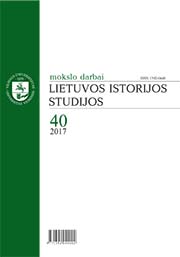LIETUVOS IR BELGIJOS PREKYBINIAI RYŠIAI 1923–1940 METAIS
TRADE RELATIONS BETWEEN LITHUANIA AND BELGIUM IN 1923–1940
Author(s): Vilma BukaitėSubject(s): Diplomatic history, Economic history, Recent History (1900 till today), International relations/trade, Interwar Period (1920 - 1939), WW II and following years (1940 - 1949)
Published by: Vilniaus Universiteto Leidykla
Keywords: Lithuania; Belgium; foreign trade; export; import; agreement;
Summary/Abstract: Economic relations between the Republic of Lithuania and the Kingdom of Belgium in 1923–1940 had well exceeded their political cooperation. Before the Great Depression, mutual trading went by a freemarket model. Two important impulses for the mutual cooperation were the introduction of the Litas (Lt), a stable Lithuanian currency, and the transfer of the Klaipėda region (Memelland), including its port, under Lithuanian governance in 1923. Most exports and imports went through the ports of Klaipėda (Memel) and Antwerp. In 1923–1925, Lithuanian exports to Belgium reached 2.5–2.8 million Lt, while imports from Belgium varied around 1–2.6 million Lt. In 1929, both exports and imports increased to 4–5 million Lt each. Traded goods reflected the type of economy and the actual needs of both people and business. At first, Lithuanian exports to Belgium consisted of domestic birds and animals, especially horses, flax seeds and fibres as well as various woods. Eventually, Belgium imported more and more processed agricultural products, like grain, butter and flax fibre. Otherwise, from the very first days of cooperation, Lithuania did import a great amount of raw iron and synthetic fertilizers, later on – building materials, like cement and glass, gears for textile production and raw materials. Oddly enough, the successful and stable growth of trading relations was not impeded by late official regulation, which had been committed just in 1928– 1932. As for the main regulation, there was used a short Temporary Agreement between Lithuania and the Belgium–Luxembourg Economic Union. Procedures for solving legal issues on trading were regulated on a deeper level. Since 1930, economic relations became more complicated, influenced by quotas and restrictions, yet the circulation of Lithuanian-Belgian exports and imports usually passed 6–7 million Lt; in some years, it had even reached 10 million Lt. As the Lithuanian-German economic relations declined, Belgium became the fourth-fifth trading partner by its importance for Lithuanian economics. Trading had depended on water traffic; thus, the Second World War greatly disturbed further economic cooperation. It was totally broken by the occupations of Lithuania and Belgium, which happened in May– June 1940.
Journal: Lietuvos istorijos studijos
- Issue Year: 2017
- Issue No: 40
- Page Range: 53-73
- Page Count: 21
- Language: Lithuanian

